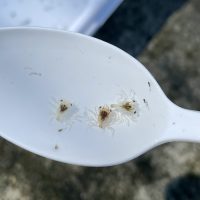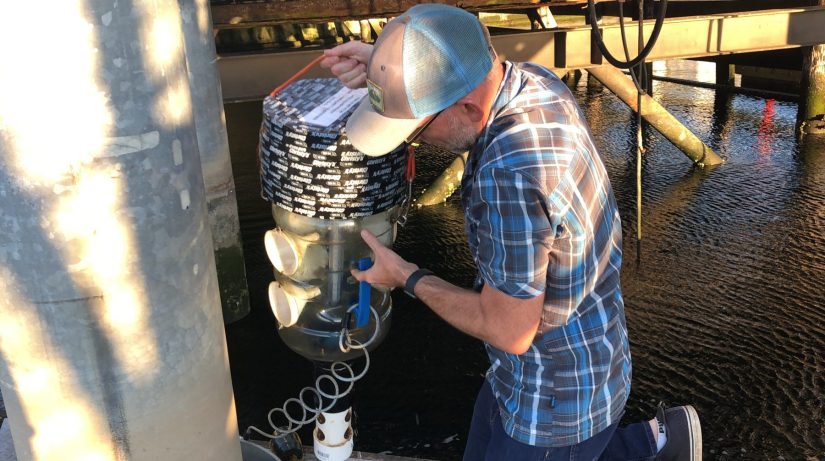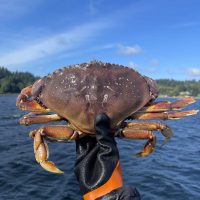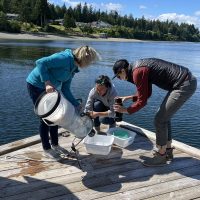A Crab Network is Connecting Communities and Generating Crucial Data for Salish Sea Fisheries
A collaborative network of agency and tribal scientists and resource managers, university faculty and students, and community volunteers are diligently working together to unlock the secrets of the Dungeness crab’s life cycle in the Salish Sea. The Pacific Northwest Crab Research Group (PCRG) is leading this unprecedented effort, generating vital data and fostering robust relationships to ensure the long-term sustainability of this ecologically, economically and culturally-important species.

“The Dungeness crab represents an iconic symbol for those who live, work and play in our region, but they also serve an important role both within the ecosystem and for the human communities who rely on them through commercial, recreational and subsistence fisheries” says Katelyn Bosley, research scientist and crab fishery manager with Washington Department of Fish and Wildlife. “The Dungeness crab fishery has a very high economic value and we must develop a better understanding of this resource to maintain a productive, resilient fishery into the future”
Recognizing the urgent need for more comprehensive data to inform management decisions, the PCRG launched a collaborative larval crab monitoring network in 2019. This ambitious project utilizes standardized light traps deployed at various locations throughout the Salish Sea to capture and study Dungeness crab megalopae, the final larval stage before they settle and transition into juvenile crabs.
PCRG’s methods and broader approach, described in a new paper published Jan. 22 in Fisheries Magazine, are the best hope for understanding this iconic crustacean.
“Our light traps are made from items found at most hardware stores, making them an approachable and cost-effective monitoring tool. They’re modeled after traps used in coastal Oregon for similar studies which use light to draw in larval marine organisms like a moth to the flame.” said Claire Cook, graduate student at the University of Washington School Aquatic and Fishery Sciences and author of the methods document used to standardize light trap monitoring across the network.

“This network really underscores the power of the collective,” said Emily Buckner, the lead author of the study and one of the PCRG program coordinators. Margaret Homerding, the Shellfish Program Manager for the Nisqually Tribe agreed, adding, “by working together we are able to collect this information across a much larger spatial scale than we could alone, giving us a much clearer picture of crab recruitment patterns in the Salish Sea and allowing us to be better stewards of the resource.”
Since its inception, the PCRG’s larval crab monitoring network has experienced remarkable growth, expanding from 16 sites in Washington in 2019 to an impressive 43 sites across Washington and British Columbia in 2023. This expansion has been driven by the enthusiastic participation of a diverse array of stakeholders, with over 85% of participating sites returning for a second year.

The meticulous data collection efforts of this dedicated network have yielded the first standardized, continuous dataset on Dungeness crab larval dynamics in the Salish Sea. This treasure trove of information has revealed fascinating insights into the species’ early life, including:
- Temporal and Spatial Trends: Megalopae were observed from April to September across all study years, with peak abundances generally occurring in June and July. Notably, larval abundance showed significant variation across the Salish Sea, consistently greatest in the central Salish Sea and north Hood Canal with lowest abundances in the southern Salish Sea and south Hood Canal.
- Seasonal Size Variation: A consistent decline in the average size of megalopae from April to September across sites and years suggests potential environmental influences on larval growth within the Salish Sea.
- Potential Coastal Subsidy: The detection of an early seasonal pulse of large megalopae, similar in size and timing to Pacific coast populations, in the Strait of Juan de Fuca and adjacent areas suggests a possible larval subsidy from the outer coast, underscoring the interconnectedness of marine populations.
The PCRG larval crab monitoring network stands as a shining example of the power of collaboration in addressing complex environmental challenges. By bringing together a diverse array of stakeholders with a shared passion for the Salish Sea, this groundbreaking project is generating the knowledge needed to inform sustainable fisheries management and ensure the long-term health of Dungeness crab.
Tandy Wilbur, Swinomish Fisheries Manager and Tribal member noted, “There is so much that we do not yet understand about Dungeness crab in the Salish Sea. As a policy-level manager for a tribal nation, we look forward to improving our ability to manage this fishery with more science-based information. But, as a long time fisherman, I can’t state enough the importance of ensuring the sustainability of the fishery for the livelihoods of members of the Swinomish community.”

Other authors of the study include: Allison Brownlee (Washington Department of Natural Resources), Julie S Barber and Sarah K Grossman (Swinomish Indian Tribal Community), Heather Earle (Hakai Institute), Bonnie Becker (UW Tacoma), Neil Harrington (Jamestown S’Klallam Tribe), P. Sean McDonald (UW Program on the Environment and School of Aquatic and Fishery Sciences), Blair Paul (Skokomish Tribe), Katie Houle (Pacific Shellfish Institute), Alexandra Galiotto (Puget Sound Restoration Fund), Gianna Pantaleo (Suquamish Tribe), and Austin Paul (Point No Point Treaty Council).
For more information, contact Emily Buckner, Crab Program Manager & Sea-Land Program Co-Lead at the Puget Sound Restoration Fund.